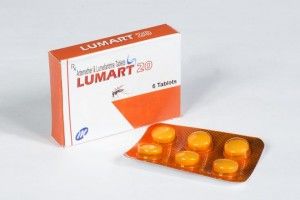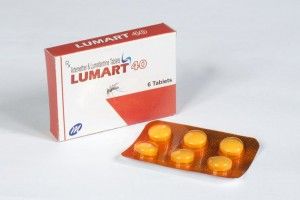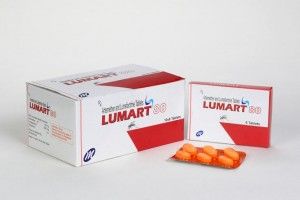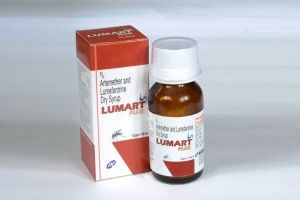
LUMART
Lumart 20
Each tablet contains
| Artemether | 20 mg |
| Lumefantrine | 120 mg |

Lumart 40
Each tablet contains
| Artemether | 40 mg |
| Lumefantrine | 240 mg |

Lumart 80
Each tablet contains
| Artemether | 80 mg |
| Lumefantrine | 480 mg |

Lumart Plus Dry Syrup
Each 5ml contains (after reconstitution)
| Artemether | 20 mg |
| Lumefantrine | 120 mg |
Description
Artemether is an Artemisinin derivative. Lumefantrine is a racemic fluorine derivative belonging to the aryl amino alcohol group of antimalarial drugs, This group includes drugs like Quinine, Mefloquine and Halofantrine.
Absorption
Artemether is absorbed fairly rapidly with peak plasma concentrations reached about 2 hours after dosing. Absorption of Lumefantrine, a highly lipophilic compound, starts after a lag-time of upto 2 hours, with peak plasma concentration about 6-8 hours after dosing. Food enhances the absorption of both artemether and lumefantrine. In healthy volunteers the relative bioavailability of artemether was increased more than two-fold and that of lumefantrine sixteen-fold, compared with fasted conditions when Lumart was taken after a high-fat meal. Food has also been shown to increase the absorption of lumefantrine in patients with malaria, although to lesser extent (approximately two-fold), most probably due to the lower fat content of the food ingested by acutely ill patients. The food interaction data indicate that absorption of lumefantrine under fasted conditions is very poor (assuming 100% absorption after a high-fat meal, the amount absorbed under fasted conditions would be < 10% of the dose). Patients should therefore be encouraged to take the medication with a normal diet as soon as food can be tolerated.
Metabolism
Artemether is rapidly and extensively metabolized (substantial first-pass metabolism) both in vitro and in humans. Human liver microsomes metabolise artemether to the biologically active main metabolite dihydroartemisinin. This metabolite has also been detected in humans in vivo. Lumefantrine is N-debutylated, mainly by CYP3A4, in human liver microsomes. In vivo in animals (dogs and rats), glucuronidation of lumefantrine takes place directly and after oxidative biotransformation. In vitro lumefantrine significantly inhibits the activity of CYP2D6 at therapeutic plasma concentrations.
Mode of Action
Parasites in the infected RBC consume haemoglobin. The ‘globin’ part is used as food by the parasite and haem from the haemoglobin is toxic for the parasite. So it is stored in a food vacuole after polymerization into non-toxic haemozoin (malaria pigment)
After absorption Artemether is metabolised into the active form dihydroartemisinin some of which get concentrated in the food vacuole of the parasite . The endoperoxide bridge of dihydroartemisinin splits the stored haemozoin and releases free radicles of iron. These free radicles of iron cause lysis of the parasite cell wall. The damage includes swelling and deformity of food vacuole membrane, nuclear membrane, and also endoplasmic reticulum and this kills the parasite.
Lumefantrine is a blood schizonticidal compound. It prevents the detoxification of haem by interfering with heamdepolymerisation process. The site of antiparasitic action of both Artemether and Lumefantrine is the food vacuole of the malarial parasite.
Elimination
Artemether is rapidly cleared from plasma with an elimination half-life of about 2 hours. Lumefantrine is eliminated very slowly with a terminal half-life of 2-3 days in healthy volunteers and 5-10 days in patients with falciparum malaria.
Indication
Uncomplicated Malaria
Dosage administration
Artemether and Lumefantrine was developed as a co-formulated (both in one tab) tablet containing 20 mg of artemether and 120 mg of Lumefantrine. Recommended as a 6 dose regimen, b.i.d (twice a day) for 3 days.
The commonly advised dosage is as follows
| Body wt. in kg | Age in years | Number of tablets at approximate timing of dosing | |||||
| 0 hr | 8 hr | 24 hr | 36 hr | 48 hr | 60 hr | ||
| 5 – 14 | < 3 | 1 | 1 | 1 | 1 | 1 | 1 |
| 15 – 24 | > 3 – 8 | 2 | 2 | 2 | 2 | 2 | 2 |
| 25 – 34 | > 9 – 14 | 3 | 3 | 3 | 3 | 3 | 3 |
| > 35 | > 14 | 4 | 4 | 4 | 4 | 4 | 4 |
Since both the ingredients are fat soluble, this drug should be taken with high fat food or a drink like milk for proper absorption.
This drug is well tolerated by children and adults with most adverse events being of mild to moderate severity and duration.
Adverse effects and contraindications: Same as for all artemisinins.
Dose Logic
The dose of Artemether is 1.6 mg /Kg body weight given twice daily when being given for 7 days (3.2 mg/ kg bw in a day). But in a shortened ACT regimen the drug is given for 3 days. For best results it is taken as 4mg/kg bw/day.
But according to the guidelines cited earlier a child of 5 kg and a child up to 14 kg receive the same dose. Which means the 5 kg child is receiving a bigger dose and the 14 kg child is receiving a smaller dose.
A drug is given in a measured dose of mg per kg body weight. One tablet as above contains 20 mg of Artemether. Since the dose is two tablets a day, for a child weighing 5 kgs, the child gets 40 mg of artemether, (8 mg/kg body wt/day) where as a 14 kg child gets (40 ÷ 14) 2.85 mg/kg body weight. Similar is the case at all body weight groups.
Presentation
| Product | Ingredients: Each Tablet contains | Pack | Box |
| Lumart 20 | Artemether 20 mg + Lumefantrine 120 mg | 6 tabs | 10 x 6 tabs |
| Lumart 40 | Artemether 40 mg + Lumefantrine 240 mg | 6 tabs | 10 x 6 tabs |
| Lumart 80 | Artemether 80 mg + Lumefantrine 480 mg | 6 tabs | 10 x 6 tabs |
| Dry Syrup Range | |||
| Each 5 ml after reconstitution contains | Pack | ||
| Lumart Plus | Artemether 20 mg + Lumefantrine 120 mg | 30ml | 60ml |
Practical scheme for administering dose of Lumart Plus Dry Syrup
5 ml = 20 mg artemether which means 1 ml = 4 mg
| Body weight | 0 hr | 8 hr | 24 hr | 36 hr | 48 hr | 60 hr |
| 5 kg | 2.5 ml | 2.5 ml | 2.5 ml | 2.5 ml | 2.5 ml | 2.5 ml |
| 10 kg | 5 ml | 5 ml | 5 ml | 5 ml | 5 ml | 5 ml |
| 15 kg | 7.5 ml | 7.5 ml | 7.5 ml | 7.5 ml | 7.5 ml | 7.5 ml |
| 20 kg | 10 ml | 10 ml | 10 ml | 10 ml | 10 ml | 10 ml |
Under this dosage a 10 kg child gets 10 ml (2x5ml) per day ie 1 ml/ kg bw / day. (in 2 divided doses).

